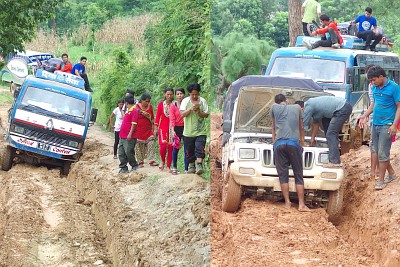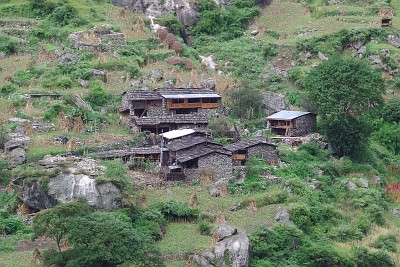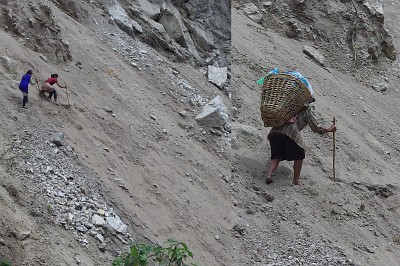From Soti Khola to Ghap
(vero;2017-Jan-31)
Trekking the Manaslu Circuit is straightforward: one starts in Soti Khola, on the banks of the Buri Gandaki, at an altitude of 700m and steadily follows the river up to its source on a glacier near the pass of Larkya La at 5160m. Then comes the big day when one crosses this high altitude pass and starts the descent down on the other side to the valley of the Marsyangdi river and the village of Dharapani at 1963m, where one meets the Annapurna Circuit.
From Soti Khola to Ghap (7 days, 04 Sept 2016 to 10 Sept 2016)
- 04 Sept: Kathmandu to Arughat
- 05 Sept: (Arughat to Soti Khola) Soti Khola (700m) to Machhakhola (930m)
- 06 Sept: Machhakhola (930m) to Pairophat Shauli Phedi (shortly after Dhoban 1070m)
- 07 Sept: Dhoban (1070m) to Nagjet (1640m)
- 08 Sept: Nagjet (1640m) to Nyak Phedi (1570m)
- 09 Sept: Nyak Phedi (1570m) to shortly after Rana (1910m)
- 10 Sept: Rana (1910m) to Ghap (2165m)
04 Sept: Kathmandu to Arughat
Search on Google Maps for Kathmandu to Soti Khola, the start of our trek, and you will read that both places are 150 km and 4 1/2 hours apart. Of course, we know better: the roads in Nepal are not Western standard and we expect a much longer journey, but we really think we can do it in one day. Well, let's see…
Santosh, our guide, picks us up at our hotel and we take a taxi to the bus station. We leave at 8am, it is raining and the roads in Kathmandu Valley are muddy — not a good start we think, even more as the previous days had been quite dry which had lulled us in taking this monsoon stuff not too seriously.
Fortunately, after a spell of heavy fog, the weather improves and all goes well until we reach the town of Dhading. Nevertheless, it took us 5 hours to cover the 90 km to get there. Once at the Dhading bus station, we are told that, due to heavy rain fall, the road to Arughat, our next stop, is so bad that they have to arrange a special 4 wheel-drive bus for the rest of the journey. Everybody leaves the bus and we wait for a good hour, Thomas making use of the time to buy all kind of biscuits and noodle soup for the trek.
The 4 WD bus finally arrives and off we go. The road is actually a dirt road, and after the heavy rains, it is indeed quite a challenge. Our bus has to go through deep ruts; we get stuck twice and everybody has to disembark and help push the bus out of the potholes. It is really impressive: the tyres are often rubbing so hard against big rocks along the road side that I expect them to burst at any moment; we have to cross deep fords and the bus rocks so heavily from one side to the other that I am afraid it might tip over to one side and stay there for good.
But we do it: it takes us another 5 hours for the 40 km to Arughat and when we arrive there, it is already dark and too late to continue to Soti Khola.
05 Sept: (Arughat to Soti Khola) Soti Khola (700m) to Machhakhola (930m)
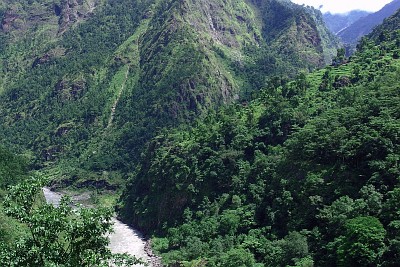 Surprisingly, it takes our 4 WD bus only one hour to cover the final 13 road kilometers to Soti Khola. All goes relatively smoothly and we take our first steps on the trek at 9am.
Surprisingly, it takes our 4 WD bus only one hour to cover the final 13 road kilometers to Soti Khola. All goes relatively smoothly and we take our first steps on the trek at 9am.
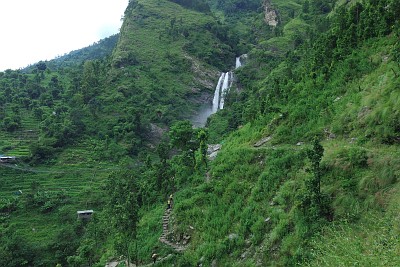 The path follows the Buri Gandaki river; the valley is very deep and narrow, so much so that there is hardly any space for villages or other trails. We have to cross many landslides caused by the heavy rains and on two occasions and to my relief, Santosh carries my backpack to help me get over some particularly difficult patches.
The path follows the Buri Gandaki river; the valley is very deep and narrow, so much so that there is hardly any space for villages or other trails. We have to cross many landslides caused by the heavy rains and on two occasions and to my relief, Santosh carries my backpack to help me get over some particularly difficult patches.
It is a hard day: extremely hot, and the humidity is killing us, sweat is running down our faces and irritating our eyes. It is also our first day and we are not yet in very good shape yet (we never are at the beginning of a trek:-).
We have a sudden bad surprise when we arrive at a suspension bridge: it is broken and being repaired — which means we have to go down to the very bottom of the valley, cross the river and climb up again to continue. We feel very discouraged and we are happy when we finally arrive in Machhakhola, shortly before 6pm. At the end of the day, we catch for the first time a glimpse of a snow summit amid the surrounding clouds: Ganesh Himal.
A bucket shower does wonders and we enjoy sitting in the shady courtyard cum garden of our tea house while we wait for the first dhal bhat of the trek and watch the locals eat tiny fried fish and let them swim in raksi.
06 Sept: Machhakhola (930m) to Pairophat Shauli Phedi (shortly after Dhoban 1070m)
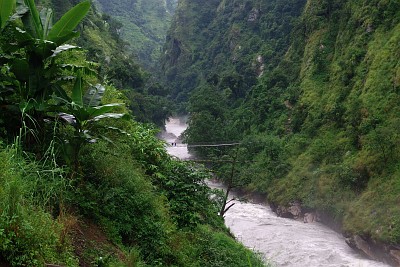 Our second day is already easier. It rains a bit, but not enough to get really wet and we get shelter under the porch of a house. Anyway, we are so soaked with sweat that it would not make much of a difference. The roaring noise of the river down the valley is omnipresent; the river currents are strong and its colour grey. A multitude of waterfalls cascade down the mountain.
Our second day is already easier. It rains a bit, but not enough to get really wet and we get shelter under the porch of a house. Anyway, we are so soaked with sweat that it would not make much of a difference. The roaring noise of the river down the valley is omnipresent; the river currents are strong and its colour grey. A multitude of waterfalls cascade down the mountain. 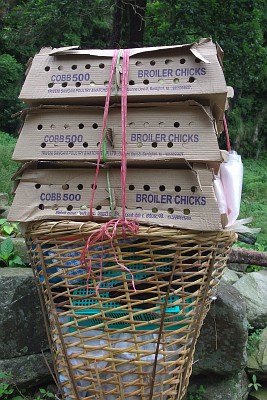
The villages and people we meet along the trail are very poor. The slopes are so steep that they are rarely suitable for cultivation; the locals rely mostly on small gardens, with a few goats and chickens while the lucky ones have one or two cows, but that's mostly it.
As yesterday, we come across many landslides and broken paths. We see a few porters and the occasional mule train, but this is nothing compared to what we know from the Everest or Annapurna regions. This part of Nepal feels very isolated indeed.
Along the way, we meet two Nepalis. They come from the Tsum Valley and advise us strongly against getting there: since the 2015 earthquake a huge landslide has blocked access to the valley and the monsoon rains have worsened the situation. They show us pictures taken with their smartphone: it is a huge steep area full with bolders and loose rocks, there are some very few steps and rickety ladders, but no safety equipment whatsoever, no guiding cables or similar and we can see Nepalis scrambling precariously up the ladders. They tell us that it is really scary and dangerous. We have to agree: going through this spot with our backpacks is probably out of the question. There is an alternative: climbing over the ridge and down to the valley, but this would involve a night camping in high altitude and we have no camping equipment.
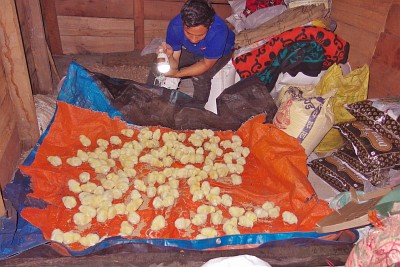 This is quite a blow; after a while, taking all this into account, we begin to reconsider our itinerary. Santosh is worried we might shorten the trek, but we reassure him. We will first check the situation at the Tsum valley entrance and, if the landslide is as dangerous as it looks, we will simply stretch the Manaslu part: shorter days, more excursions — which means more days needed to reach the Annapurna circuit. No sooner said than done: instead of heading to Jagat as originally planned, we decide to shorten the day and stop in Dhoban for the night. But we are not impressed by the lodge there: it is big and looks good, but it is quite expensive and the hostess is not exactly friendly and welcoming. So we prefer to continue until, shortly after Dhoban, we find a single tea house located along the trail at Pairophat Shauli Phedi.
This is quite a blow; after a while, taking all this into account, we begin to reconsider our itinerary. Santosh is worried we might shorten the trek, but we reassure him. We will first check the situation at the Tsum valley entrance and, if the landslide is as dangerous as it looks, we will simply stretch the Manaslu part: shorter days, more excursions — which means more days needed to reach the Annapurna circuit. No sooner said than done: instead of heading to Jagat as originally planned, we decide to shorten the day and stop in Dhoban for the night. But we are not impressed by the lodge there: it is big and looks good, but it is quite expensive and the hostess is not exactly friendly and welcoming. So we prefer to continue until, shortly after Dhoban, we find a single tea house located along the trail at Pairophat Shauli Phedi.
This tea house is not aimed at tourists, and our host has to open a separate room in which he brings two wooden beds to accommodate us. Washing is in a bowl, in the privacy of our room, we miss the refreshing bucket shower of yesterday. But the dhal bhat is good and the evening very entertaining: porters are also spending the night here. They sleep in the restaurant room, on banks or on the floor, like Santosh.
One of the porters is transporting 150 one-day-old chicks to the village of Yaru. He has two days to cover the distance, left Soti Khola this morning and will reach Yaru tomorrow mid morning. The chicks are transported in three cardboard boxes à 50 chicks stapled in his doko, each box divided in four compartments. As soon as he arrives, he checks with our host and is shown a shed where he deploys a big plastic sheet where all chicks are let loose for a short period (around 20 minutes), enough time for them to get some water and pick some rice corns under the light of a torch. He is relieved to see that he has only lost one chick so far (crushed to death in the box): each chick costs him 80 Rs and one dead chick means 80 Rs less at the end of the day. Click on the arrow to listen to 150 chicks in a doko: 
Once in Yaru, the chicks are fattened until they are strong enough to be transported higher up along the trail. Indeed, on the following day, we'll see a procession of six porters leaving Yaru for Samagaon, each carrying 20 chickens in their doko.
07 Sept: Dhoban (1070m) to Nagjet (1640m)
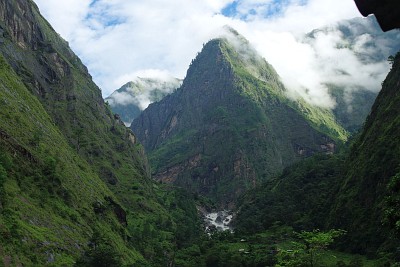 A good day. For once, there are fewer clouds and we can see more of the landscape, particularly the green slopes and craggy mountains above us. We have breakfast in Yaru. After the village, a metallic walkway has been built against the steep mountain wall and this allows us to progress without wading in the river. A nice piece of work and the opportunity for a great photo session with Santosh.
A good day. For once, there are fewer clouds and we can see more of the landscape, particularly the green slopes and craggy mountains above us. We have breakfast in Yaru. After the village, a metallic walkway has been built against the steep mountain wall and this allows us to progress without wading in the river. A nice piece of work and the opportunity for a great photo session with Santosh.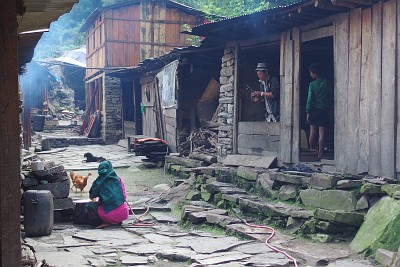
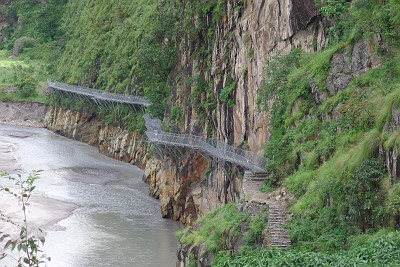 We have to stop in Jagat for registering with the authorities and a passport and permit check. As soon as we enter MCAP (Manaslu Conservation Area Project) territory, we notice that the villages look cleaner and slightly wealthier. The houses are for once made of grey stone and the village main “streets” are paved with grey slabs. But all this greyness makes for a bleak picture, especially when there is no sun or when it rains. We continue to Salleri, a pleasant village where we have a long break in the sun. Villagers are sitting in front of their house and are plucking grains off corn cobs: they will be used to produce raksi, a local alcoholic drink. They offer each of us a huge banana: the skin is very thick and hard to peel but the fruit is delicious.
We have to stop in Jagat for registering with the authorities and a passport and permit check. As soon as we enter MCAP (Manaslu Conservation Area Project) territory, we notice that the villages look cleaner and slightly wealthier. The houses are for once made of grey stone and the village main “streets” are paved with grey slabs. But all this greyness makes for a bleak picture, especially when there is no sun or when it rains. We continue to Salleri, a pleasant village where we have a long break in the sun. Villagers are sitting in front of their house and are plucking grains off corn cobs: they will be used to produce raksi, a local alcoholic drink. They offer each of us a huge banana: the skin is very thick and hard to peel but the fruit is delicious.
When we arrive in Sirdibas, nobody seems to know whether the trekking lodges are open, somebody quotes a completely crazy price of 1000 Rs for the night without food. There is no way we will pay that much! We ignore this blackmail and encouraged by the pleasant experience in our local tea house yesterday, decide to continue in search of similar accommodation. We arrive eventually at the settlement of Nagjet.
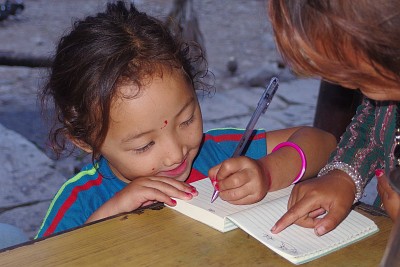 Nagjet consists of 2 or 3 local lodges, with some rooms and food available. This is a popular stop for mule trains: for once, there are some flat and wide expanses of grass where the mules can spend the night and a brook where the mule drivers can have a wash and get water for their animals. We are early and get a room, and it is once again washing in a bowl. We have hardly met anybody on the trail today, but as the afternoon goes on, many mule trains, on their way to Sama, begin to arrive. It is interesting to watch the mule drivers going about their job: as soon as they arrive, they take the loads off their mules. The mules are very appreciative, some start immediately to wallow on the ground, probably to scratch their irritated backs. Then they are fed and brought to the brook for drinking, before being let into an enclosure for the night.
Nagjet consists of 2 or 3 local lodges, with some rooms and food available. This is a popular stop for mule trains: for once, there are some flat and wide expanses of grass where the mules can spend the night and a brook where the mule drivers can have a wash and get water for their animals. We are early and get a room, and it is once again washing in a bowl. We have hardly met anybody on the trail today, but as the afternoon goes on, many mule trains, on their way to Sama, begin to arrive. It is interesting to watch the mule drivers going about their job: as soon as they arrive, they take the loads off their mules. The mules are very appreciative, some start immediately to wallow on the ground, probably to scratch their irritated backs. Then they are fed and brought to the brook for drinking, before being let into an enclosure for the night.
We spend a very pleasant evening. The lodge is busy and Pritina, the 4-year-old daughter of our hosts has adopted us. She is a bright child and keen on showing off her writing. We are impressed; I cannot keep up and have to write words, sentences or make simple drawings which Pritina copies zealously in our diary, always asking for more. Her parents are very proud of her.
08 Sept: Nagjet (1640m) to Nyak Phedi (1570m)
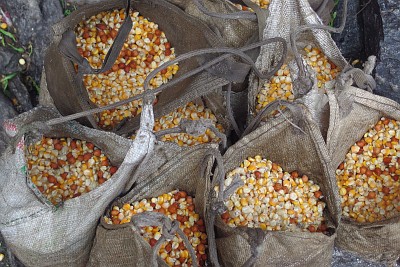 The day starts pleasantly: we watch the mule trains getting ready while drinking our tea and munching our biscuits. Each mule gets a soft bucket full with corn which is hung to its neck for eating without spilling. Then the loads are fastened on their back and off they go…
The day starts pleasantly: we watch the mule trains getting ready while drinking our tea and munching our biscuits. Each mule gets a soft bucket full with corn which is hung to its neck for eating without spilling. Then the loads are fastened on their back and off they go…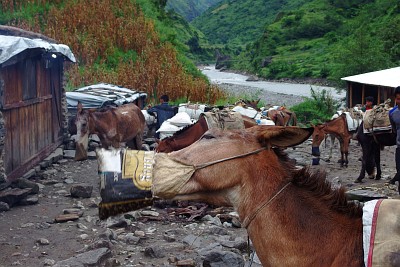
We follow shortly after and make a long breakfast break in Ekle Bahtti (meaning single inn) where Santosh disappears in a garden and comes back with ripe cucumbers.
Santosh is a devotee to the “living-from-the-land-concept”: he often brings apples, melons, nuts, or other, stranger fruits which people give him or which he simply gets from some bushes/gardens and which he always shares with us, happy to deepen our knowledge of local products. This time is no exception: he has found a cucumber garden and brings some greenish-yellow fruits.
I am the first to taste and immediately spit everything out: Yuk! It tastes incredibly bitter! Thomas bites, chews and swallows a bit and doesn't like it either. Even Santosh must admit that it doesn't taste good at all. We throw the cucumbers away and set off.
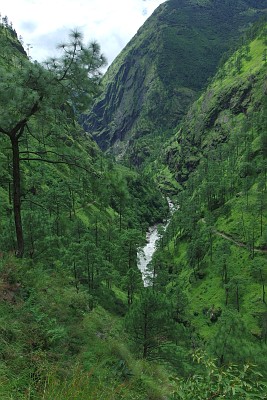 Some 10 or 15 minutes later, Thomas starts feeling queasy and then really unwell — so bad indeed that he throws up. We continue, but he has to throw up again, three times, and he feels weaker and weaker. We have to stop for a longer break, and Santosh starts to throw up as well. Oh my god… I am the only one not suffering, this must have to do with the cucumbers… After a long rest, both are OK to go and we continue on our way very slowly. We wanted to climb up to Lokpa, the first village on the way to the Tsum Valley and spend the night there before descending back to the Manaslu trail the next day. This is quite tough for the men: 280 altitude meters… But both men are valiant and we eventually get there, just to find out that the lodges are closed (well, nobody goes to Tsum Valley anymore, so what's the point) and they quote us a fortune to open them for us. The alternative would be to go 300m higher, to Upper Lokpa, where we would find an open lodge.
Some 10 or 15 minutes later, Thomas starts feeling queasy and then really unwell — so bad indeed that he throws up. We continue, but he has to throw up again, three times, and he feels weaker and weaker. We have to stop for a longer break, and Santosh starts to throw up as well. Oh my god… I am the only one not suffering, this must have to do with the cucumbers… After a long rest, both are OK to go and we continue on our way very slowly. We wanted to climb up to Lokpa, the first village on the way to the Tsum Valley and spend the night there before descending back to the Manaslu trail the next day. This is quite tough for the men: 280 altitude meters… But both men are valiant and we eventually get there, just to find out that the lodges are closed (well, nobody goes to Tsum Valley anymore, so what's the point) and they quote us a fortune to open them for us. The alternative would be to go 300m higher, to Upper Lokpa, where we would find an open lodge.
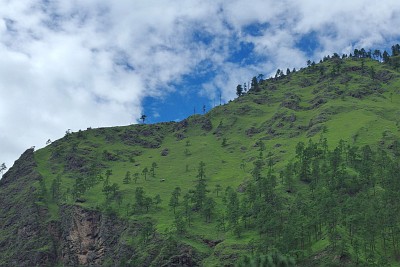 After discussing our options, we decide to go back down to the Manaslu circuit and stop at the first available accommodation. All those vertical meters, done for nothing! Being the only fit person in our little group, I actually quite enjoy the trek to Lokpa: the path is nice and easy going, through a forest with great views on the other side of the river, it would have been perfect, if it had not been for the cucumbers. No need to say that Santosh feels very guilty. After inquiring, he is told by villagers that he picked “wild cucumbers”: not poisonous and used by the locals as a medicine “to clean their stomachs”. Well, we can confirm that the cleaning bit does work!
After discussing our options, we decide to go back down to the Manaslu circuit and stop at the first available accommodation. All those vertical meters, done for nothing! Being the only fit person in our little group, I actually quite enjoy the trek to Lokpa: the path is nice and easy going, through a forest with great views on the other side of the river, it would have been perfect, if it had not been for the cucumbers. No need to say that Santosh feels very guilty. After inquiring, he is told by villagers that he picked “wild cucumbers”: not poisonous and used by the locals as a medicine “to clean their stomachs”. Well, we can confirm that the cleaning bit does work!
We return to the river and quickly find a tourist lodge where we are happy to stop. We are the only customers and the evening is a bit long; we are missing the action of the last evenings. Our hosts, two young sisters of around 25, are a bit weird: we do not see them a lot as they keep to the kitchen and do not invite us in. So we stay in the empty and cold dining room and during the whole time they are busy with their smartphones, watching videos, playing games; it is disconcerting to see them so absorbed, oblivious to the rest of the world (and us). There is at least one advantage in staying here: we can have a bucket shower in the toilet shed. As we change clothes, we discover that leeches have feasted on us: I have three suction marks, Thomas one.
09 Sept: Nyak Phedi (1570m) to shortly after Rana (1910m)
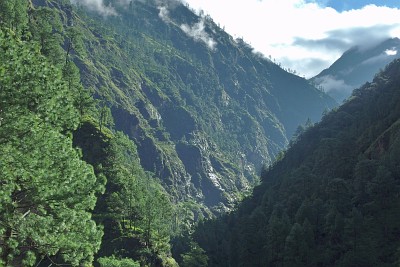 A short day. We continue to make our way up the valley, in pretty much the same scenery as the days before. Sometimes, when we look back, the vegetation is so dense and the valley so narrow that we can hardly see the path which we have just walked along. The weather is nice and there is blue sky to be seen up valley, that's where we are heading to and we hope this is a good sign.
A short day. We continue to make our way up the valley, in pretty much the same scenery as the days before. Sometimes, when we look back, the vegetation is so dense and the valley so narrow that we can hardly see the path which we have just walked along. The weather is nice and there is blue sky to be seen up valley, that's where we are heading to and we hope this is a good sign.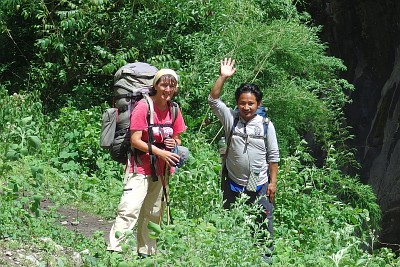
We make a lunch break in Deng, and are overtaken by three small parties, no more than two trekkers in each group, some in the company of a guide only, others with guide and porters. The villages along the way are more like hamlets, groupings of 2 to 4 houses and sometimes, as in Deng, they consist of just a collection of lodges. All is very simple and rather dull and depressing. As we go on, we have the feeling that the valley gets wider to the west: maybe we'll find bigger villages during the next days. A sign that we are making good progress: we have today seen our first mani wall, completely overgrown, but this means that we are entering Buddhist territory!
With so much time on our hands there is no reason for us to hurry and we decide to stay for the night at a single house shortly after Rana. A bit disappointed by the rather boring evening the day before, we are keen on getting in touch with locals and have asked Santosh to look for non-tourist accommodation.
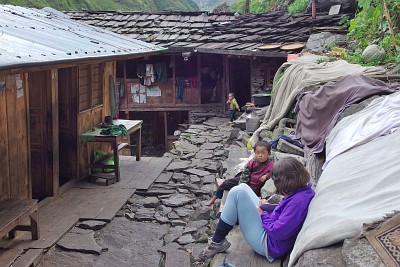 The man who lives here is keen to have us as guests and is happy about the extra money we are bringing into the family. We do not go into the house, we will sleep on a mattress on the floor in an empty room with table and banks next to his small shop. This must have been a kind of restaurant before but is not used anymore. The shop is still there, but there is not much to sell: a few noodle soups, biscuits. Some people stop and buy a few things as we are here, but this is nothing really worth mentioning.
The man who lives here is keen to have us as guests and is happy about the extra money we are bringing into the family. We do not go into the house, we will sleep on a mattress on the floor in an empty room with table and banks next to his small shop. This must have been a kind of restaurant before but is not used anymore. The shop is still there, but there is not much to sell: a few noodle soups, biscuits. Some people stop and buy a few things as we are here, but this is nothing really worth mentioning.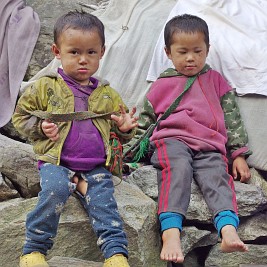
The man is very friendly and quite stressed: his wife has been sick for a few days now (dysentery) , and indeed, we can see her, lying down most of the time and when she wanders around, she seems weak and completely apathetic, oblivious to everything around her including her children. They are two brothers, we guess 4 and 6 years old. They are very shy and incredibly dirty. So, it all falls to the father who has to continue his usual work and additionally cares for the family. While he goes about his chores, we try to make friends with the kids.
They make a very sad impression and we have the feeling that it is not only because of their sick mother: they are so isolated, without any friends around, they obviously lack any kind of stimulation. As the afternoon advances, both of them get used to us, the older one even playing and laughing a bit with Thomas. They both have a small cloth bag around their shoulders. Santosh tells us that it is typical for Nepalese children, he also had one when he was a boy: that's where he kept a few toys, his small treasures and a snack for the day. The bags of our two brothers are empty. What a difference to the 4-year-old Pritina in Nagjet!
The brothers' future is not looking bright either: the nearest school is in Philim, a village on the other side of the river, opposite Nagjet. Much too far for two little boys. So they will stay home and get occasional education from monks. We are shocked at so much poverty but to our surprise, Santosh replies that this family, compared to others living around, is not as poor as we think. They have a house, a shop, a garden and a few animals: they are not doing badly.
In the evening, a young neighbour comes and brings yoghurt and beaten rice for the mother, this is supposedly a cure against diarrhea. Unfortunately, as we leave the next morning, the woman is no better.
10 Sept: Rana (1910m) to Ghap (2165m)
A nice day, although the clouds are hanging low. We pass isolated farm houses, corn fields and there is marijuana growing along the path. Indeed, the valley opens slowly and this is enough to make us happy.
We are suddenly confronted with an impressive landslide which seems to be relatively recent. The mule trains are re-routed and have to make a detour some 100 altitude meters higher before regaining the path, but it looks as if it is possible for us to cross and avoid the additional climb. There are some Nepalis on the other side coming toward us and we watch them cross the obstacle before going ourselves. Santosh goes first with his pack and then returns: I am glad that he volunteers to carry my bag and I follow him a bit scared. Then Thomas crosses too.
This is quite thrilling for us and also for the Nepalis; a barefoot porter with a doko on his back makes a prayer before setting off, we are happy to see him safely arrive on the other side.
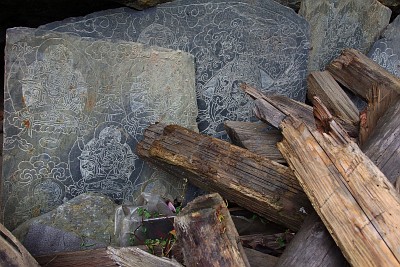 We approach Ghap and the first house we come to is a tourist lodge. It looks simple and so welcoming with its garden and veranda that we immediately fall in love with it and decide to stop there. Our hosts are in their fifties, friendly and their features are clearly Tibetan. Their kitchen is very dark, there is no chimney, the smoke escapes through the roof and we are happy to have a separate dining room. Compared to our very basic night yesterday, we are enjoying the privacy of our room, have a good wash and do some laundry. After a cup of salt tea and a corn cob offered by our hosts we leave Santosh in front of the fire and go for a stroll through Ghap. There is not much to it: a stupa and some mani walls, all heavily damaged since the 2015 earthquake and some more lodges. Again, this is not a “real” village. But we like it here and we hope for nice weather tomorrow: we would like to explore the other side of the valley, this would make a perfect day trip and enable us to stay a second night in our friendly lodge.
We approach Ghap and the first house we come to is a tourist lodge. It looks simple and so welcoming with its garden and veranda that we immediately fall in love with it and decide to stop there. Our hosts are in their fifties, friendly and their features are clearly Tibetan. Their kitchen is very dark, there is no chimney, the smoke escapes through the roof and we are happy to have a separate dining room. Compared to our very basic night yesterday, we are enjoying the privacy of our room, have a good wash and do some laundry. After a cup of salt tea and a corn cob offered by our hosts we leave Santosh in front of the fire and go for a stroll through Ghap. There is not much to it: a stupa and some mani walls, all heavily damaged since the 2015 earthquake and some more lodges. Again, this is not a “real” village. But we like it here and we hope for nice weather tomorrow: we would like to explore the other side of the valley, this would make a perfect day trip and enable us to stay a second night in our friendly lodge.
Go back to Around Manaslu or go on to From Ghap to Dharapani
$ updated from: Around Manaslu.htxt Mon 28 Apr 2025 14:55:28 trvl2 — Copyright © 2025 Vero and Thomas Lauer unless otherwise stated | All rights reserved $




